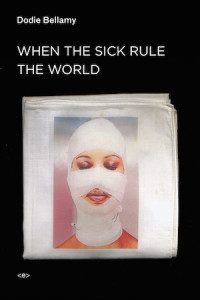
Dodie Bellamy’s latest work, When The Sick Rule The World, is a series of biting, ouroboric takes on the bi-polar allure of sickness, a fantastic book of psychic bloodletting and cauterizing ironies. This is a hybrid collection, at once essayistic and anecdotal, shifting between memoir and fiction as though testing new medicines for maladies in and of the mind, the body, and the body politic. Bellamy’s takes on sickness, and very personal grief, suggest healing without sanctimony. You can trust me on this; I am writing from Santa Fe, NM, where Our Lady is Julianne Moore in Todd Haynes’ Safe, and don’t you know that she is also Emily Dickinson? Of this, more later.
This cloud of sexuality has overtaken me, like when the mosquito man drove his truck through the neighborhood, trailing a thick white cloud of pesticide, and all us kids chased behind it thrilled to be running in a cloud, like heaven had touched down in a sharp chemical stunted tinged with sweetness, and afterwards we were so dizzy we sprawled on twilight-cooled lawns in a swoon. When I was in high school, boys either ignored or ridiculed me, the nightmarish ones made wolf-whistles and laughed their asses off—and now this high school boy wants to fuck me. My upper mouth is saying no, but my nether mouth is moaning boy meat…yes…yes…now.
“Whistle While You Dixie” opens with a Freudian case of misophonia, a dread of whistling, and works through the absence of whistling in Snow White’s “Whistle While You Work” and Billy Currington’s “dangerously seductive” rendering of “You Ain’t Just Whistling Dixie” towards an anguished near-infidelity in a motel room with a teenage, glue sniffing truck driver. Bellamy analyses the barely concealed interspecies anality and jack-offs in the Disney animation, modes then of a kind of “sick”-ness that passes code in naive animation but would be transgressive in John Waters: why, of course, the asshole is for cleaning dishes. The chipmunks are Divine, darling. Infection in the relationship: How ‘sick’ would it be to crawl from the motel bed she shares with her husband into the neighboring bed of the “hormonal youth,” the “libidinous teen”? Her husband Greg “is like Teflon to my consciousness, his presence keeps slipping away.” Finally, “What I did was to fuck Greg—quietly of course,” avoiding the hysterical sonic utterance of her “upper mouth” informed by the Freudian lower. The brilliance of the scene is contained in: “Streetlight streaked in through the edges of the motel curtain as both beds creaked in unison.” The boy masturbates to the sex in the other bed. In infectious terms, it’s a take on proximity and proxy. In Freudian terms, it is perhaps best read with Greg absent, like the whistling, so that he occurs as the ghost of guilt, haunting, the (un)presence of the (un)sick.
Do the jumbled clothes of a cult writer nine years after her death, stacked in storage boxes in a room at the back of a garage mean anything? The clothes shift and twist—no logic in their contortions beyond the dumb fact of their being uninhabited. Sometimes I get all left brain and I tell myself to stop being so superstitious, so woo woo mystical about all of this. “These effects of Kathy’s,” my left brain says to me, “these trinkets of wool and silver, are just objects, mere dumb objects. But no matter how I try to rationalize them, they will not stop pointing to their thingness listen to me listen to me. Acker: To live was to stay alive and not be reduced to materiality.
In “Digging Through Kathy Acker’s Stuff” Bellamy plays Narnia with Kathy Acker’s wardrobe; Acker as the preeminent icon of the postmodern resolution of Emily Dickinson’s “infection in the sentence,” Acker whose physical body-as-text was overwhelmed by cancer in 1997. I am writing this with an eight-inch tattoo from Empire of the Senseless on my right arm. At issue here are the writer as féticheur and fetish, grimoire and glamor; cancer, sickness as a genetic —that is textual— insurgence, fashion as palliative, and as the epigram from Christian Dior states: “Fashion is a dream haunted by dresses.” Ostensibly, the piece concerns Bellamy’s ‘quest’ to possess a piece of Acker’s jewelry promised to her by the executor of the Acker estate, Matias Viegener. Truly, it concerns the bloodstream of literature and the (almost) louche pop vampirism of the avant-garde, the risky/risqué promiscuous intertextuality and appropriation/plagiarism that was part of the context of Bellamy’s Real: The Letters of Mina Harker and Sam D’Allesandro (1994), and of theorized writing slipping along the Teflon-clad canon. From those circumstances, Jack Halberstam wrote that the —now posthuman— “body is a technology, a screen, a projected image; it is a body under the sign of AIDS, a contaminated body, a deadly body, a techno-body; it is, as we shall see, a queer body. The human body itself is no longer part of the “family of man” but of a zoo of posthumanities.” (Posthuman Bodies, 1995) “Digging Through…” is characterized by doubt, tenderness, and some antagonism. It is a case study in haunting and the tension between (un)belonging and longing so symptomatic of ‘the Artist,’ and of everyday alienation in an environment where sickness is our metaphor and our so-called reality.
When the sick rule the world the well will be servants, and all the well will try to become sick so they too can have servants. Pretending to be sick will be a capital offense. When the sick rule the world the limbs of the well will be chopped off in the middle of the night, the well one still alive, flailing and screaming. The limbs of the well will fetch exorbitant fees on the black market, sold to sorcerers who will dry the limbs and grind them into magic powders to be placed into amulets to ward off blindness and toxins. These amulets will bring prosperity to their owners.
“When The Sick Rule The World” is a satirical SCUM Manifesto for the sick, and A Modest Proposal for the environmentally hypersensitive. Within, of course, lies a critique of that culture of the ‘well’ that mocks the invisible sickness of others, yet romances its own visible symptoms. The invisibly sick, the suspected hypochondriacs, avenge themselves by leaving undeniable wounds upon the well. “The sick will travel in packs commandeering porcelain-lined fragrance-free buses… All existing new cars will be remaindered and shipped to Cuba… Gas masks will be sexy…” The sick are the most self-conscious victims of capitalism and its products, and the airwave- and microwave-borne pablum of its communications. “When The Sick Rule The World” informs us that yes, perhaps gas masks will be sexy, because necessary; an environmental Marxism of the flesh.
When the sick rule the world mortality will be sexy. When the sick rule the world, all writing will be short and succinct, no paragraphs will be longer than two sentences so we can comprehend them through the brain fog the well bring to us daily.
We have always found mortality sexy; we’re still (Edgar Allan) Poe-faced about it, because we’ve never escaped the cocoon of romanticism. The well are complicit in sickness and each defines the other’s permeable borders. One of the ironies of Dodie Bellamy’s work is that the ineffable glamor of pop culture, of simulacra, is a consolatory presence within the toxicity of the capitalism and its costumes. During the filming of Spielberg’s E.T., Bellamy reports, the rubber body of alien was worn by a series of actors under three feet tall, the burden of the extraterrestrial’s skin something like a CIA torture. In “Phone Home” she writes: “E.T.’s death is my mother’s death… E.T. calls us back to the pre-symbolic, the burden of otherness we’ve carried since we left the primal ooze of our mother’s body.” E.T. the film as a shared experience between Bellamy and her mother is a psychic conduit. E.T. is also “the angel of death.” But, E.T.’s ‘death’ in the film is temporal. His rejuvenation is the hope, after the death of her mother, for the end of fragmentation, for a safe place: “Home is an instinct, a yearning that has never, ever been satisfied, that can never be eradicated, an itch we will scratch until the day E.T. comes to harvest our souls…”
Having entered the arena of the unwell, Dodie Bellamy has produced a book with admirable grit and wit, a thousand wards away from literary rubbernecking, or what a sales rep from HarperCollins once described to me as “another book for ambulance chasers.” When The Sick Rule The World presents the unremitting paradox of being, of isolation, alienation and modes of sickness with wicked compassion and bemused tears, the darkest humor and scintillating truths.





